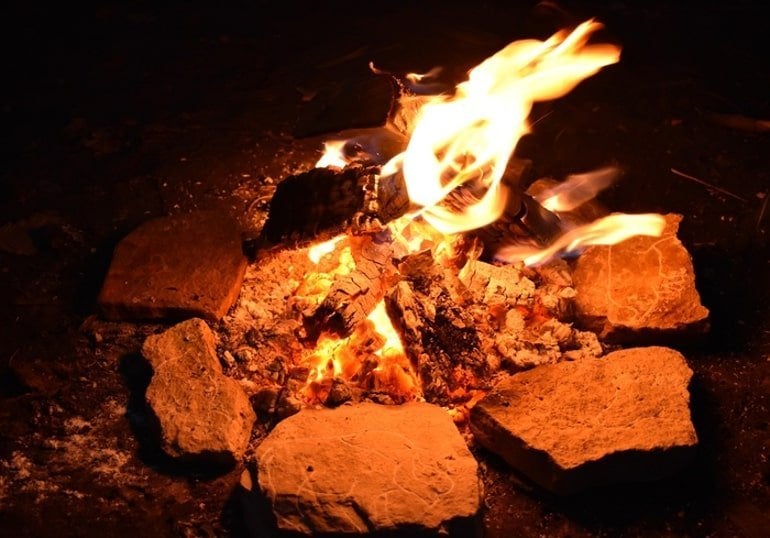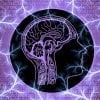Prehistoric People Created Art by Firelight
5 min read [ad_1]
Summary: An examination of artistic designs on stones believed to be over 15,000 years old reveals our early ancestors probably created intricate artwork by firelight.
Source: University of York
Our early ancestors probably created intricate artwork by firelight, an examination of 50 engraved stones unearthed in France has revealed.
The stones were incised with artistic designs around 15,000 years ago and have patterns of heat damage which suggests they were carved close to the flickering light of a fire, the new study has found.
The study, by researchers at the Universities of York and Durham, looked at the collection of engraved stones, known as plaquettes, which are now held in the British Museum. They are likely to have been made using stone tools by Magdalenian people, an early hunter-gatherer culture dating from between 23,000 and 14,000 years ago.
The researchers identified patterns of pink heat damage around the edges of some of the stones, providing evidence that they had been placed in close proximity to a fire.
Following their discovery, the researchers have experimented with replicating the stones themselves and used 3D models and virtual reality software to recreate the plaquettes as prehistoric artists would have seen them: under fireside light conditions and with the fresh white lines engravers would have made as they first cut into the rock thousands of years ago.
Lead author of the study, Dr Andy Needham from the Department of Archaeology at the University of York and Co-Director of the York Experimental Archaeology Research Centre said: “It has previously been assumed that the heat damage visible on some plaquettes was likely to have been caused by accident, but experiments with replica plaquettes showed the damage was more consistent with being purposefully positioned close to a fire.
“In the modern day, we might think of art as being created on a blank canvas in daylight or with a fixed light source; but we now know that people 15,000 years ago were creating art around a fire at night, with flickering shapes and shadows.”
Working under these conditions would have had a dramatic effect on the way prehistoric people experienced the creation of art, the researchers say.
It may have activated an evolutionary capacity designed to protect us from predators called “Pareidolia”, where perception imposes a meaningful interpretation such as the form of an animal, a face or a pattern where there is none.
Dr Needham added: “Creating art by firelight would have been a very visceral experience, activating different parts of the human brain. We know that flickering shadows and light enhance our evolutionary capacity to see forms and faces in inanimate objects and this might help explain why it’s common to see plaquette designs that have used or integrated natural features in the rock to draw animals or artistic forms.”

The Magdalenian era saw a flourishing of early art, from cave art and the decoration of tools and weapons to the engraving of stones and bones.
Co-author of the study, PhD student Izzy Wisher from the Department of Archaeology at the University of Durham, said: “During the Magdalenian period conditions were very cold and the landscape was more exposed. While people were well-adapted to the cold, wearing warm clothing made from animal hides and fur, fire was still really important for keeping warm. Our findings reinforce the theory that the warm glow of the fire would have made it the hub of the community for social gatherings, telling stories and making art.
“At a time when huge amounts of time and effort would have gone into finding food, water and shelter, it’s fascinating to think that people still found the time and capacity to create art. It shows how these activities have formed part of what makes us human for thousands of years and demonstrates the cognitive complexity of prehistoric people.”
About this evolutionary neuroscience and art research news
Author: Shelley Hughes
Source: University of York
Contact: Shelley Hughes – University of York
Image: The image is credited to Needham et al., 2022,
Original Research: Open access.
“Art by firelight? Using experimental and digital techniques to explore Magdalenian engraved plaquette use at Montastruc (France)” by Needham et al. PLOS ONE
Abstract
See also

Art by firelight? Using experimental and digital techniques to explore Magdalenian engraved plaquette use at Montastruc (France)
Palaeolithic stone plaquettes are a type of mobiliary art featuring engravings and recovered primarily from Magdalenian sites, where they can number from single finds to several thousand ex
amples. Where context is available, they demonstrate complex traces of use, including surface refreshing, heating, and fragmentation.
However, for plaquettes with limited or no archaeological context, research tends to gravitate toward their engraved surfaces.
This paper focuses on 50 limestone plaquettes excavated by Peccadeau de l’Isle from Montastruc, a Magdalenian rockshelter site in southern France with limited archaeological context; a feature common to many art bearing sites excavated across the 19th and early 20th Centuries. Plaquette use at Montastruc was explored via a programme of microscopy, 3D modelling, colour enhancement using DStretch©, virtual reality (VR) modelling, and experimental archaeology, the latter focusing on limestone heating related to different functional and non-functional uses.
While the limited archaeological context available ensures the results remain only indicative, the data generated suggests plaquettes from Montastruc were likely positioned in proximity to hearths during low ambient light conditions.
The interaction of engraved stone and roving fire light made engraved forms appear dynamic and alive, suggesting this may have been important in their use. Human neurology is particularly attuned to interpreting shifting light and shadow as movement and identifying visually familiar forms in such varying light conditions through mechanisms such as pareidolic experience.
This interpretation encourages a consideration of the possible conceptual connections between art made and experienced in similar circumstances, such as parietal art in dark cave environments.
The toolset used to investigate the Montastruc assemblage may have application to other collections of plaquettes, particularly those with limited associated context.
[ad_2]
Source link







